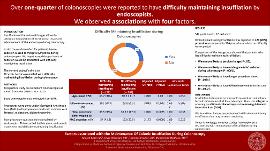| dc.description.abstract | Colonoscopy is a diagnostic and therapeutic procedure performed for several indications including colorectal cancer (CRC) screening, adenoma surveillance, and investigation of gastrointestinal symptoms. Insufflation of the colon with gas allows for adequate visualization of the mucosal tissue and advancement of the endoscope; however, it can cause pain and discomfort. Thus, the majority of colonoscopies are performed with sedation in order to mitigate discomfort and enhance the colonoscopy experience for both the patient and the endoscopist. We hypothesized that deeper levels of sedation would lead to more difficulty in maintaining insufflation. We aimed to evaluate factors associated with difficulty maintaining insufflation.
Methods: We performed a prospective study of all patients who underwent outpatient colonoscopies at the Veteran Affairs Medical Center in Oklahoma City between November 2019 and March 2020. Colonoscopies were performed by gastroenterology fellows and attending gastroenterologists. Indications for colonoscopies were CRC screening, positive fecal immunochemical test, symptomatic, and adenoma surveillance. Procedures were done under Monitored Anesthesia Care (MAC) with propofol or moderate sedation with fentanyl, midazolam, and diphenhydramine. Insufflation was done with carbon dioxide.
Data collection involved two parts. Firstly, baseline demographic information was obtained from the electronic medical record (EMR) along with colonoscopy details including type and doses of sedatives; total number of polyps, size of polyps, and specific location in colon; and total procedure times including insertion and withdrawal. Secondly, a post-procedure questionnaire was completed by the endoscopists and recorded the bubble score, endoscopic maneuvers, and difficulty maintaining insufflation.
Results: A total of 542 participants underwent colonoscopies during this period. Twelve participants were excluded from the study and 37 participants did not have completed questionnaires. We found that difficulty maintaining insufflation was reported in 129 (26%) participants compared to 364 participants where no difficulty was reported.
Multivariate analysis showed that patients who had difficulty maintaining insufflation were more likely to be of an older age (P=0.003), had undergone MAC sedation (P=<0.0001), were more likely to have longer procedure times (P=.0025) and fellow involvement (P=0.0002) with the procedure.
Discussion: We observed that difficulty in maintaining insufflation during colonoscopy was reported in over one-quarter of the colonoscopies done. We found four factors associated with difficulty maintaining insufflation: use of propofol sedation, older age, fellow involvement, and longer procedural times. We could not find literature that explored maintenance of insufflation. Further investigation into these factors and their relationship with maintaining insufflation is warranted as this may improve the colonoscopy experience. | en_US |

